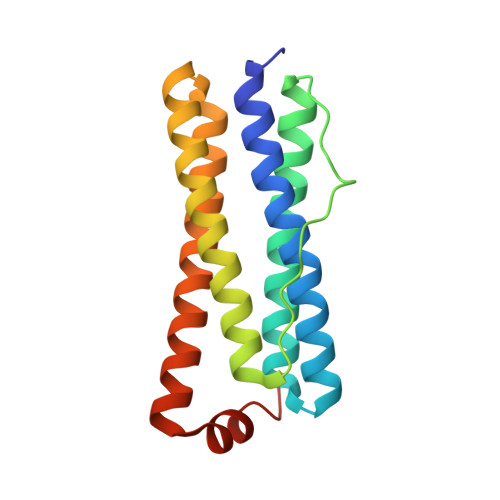Small Molecule Inhibitors of the BfrB-Bfd Interaction Decrease Pseudomonas aeruginosa Fitness and Potentiate Fluoroquinolone Activity.
Punchi Hewage, A.N.D., Yao, H., Nammalwar, B., Gnanasekaran, K.K., Lovell, S., Bunce, R.A., Eshelman, K., Phaniraj, S.M., Lee, M.M., Peterson, B.R., Battaile, K.P., Reitz, A.B., Rivera, M.(2019) J Am Chem Soc 141: 8171-8184
- PubMed: 31038945
- DOI: https://doi.org/10.1021/jacs.9b00394
- Primary Citation of Related Structures:
6NLF, 6NLG, 6NLI, 6NLJ, 6NLK, 6NLL, 6NLM, 6NLN - PubMed Abstract:
The iron storage protein bacterioferritin (BfrB) is central to bacterial iron homeostasis. The mobilization of iron from BfrB, which requires binding by a cognate ferredoxin (Bfd), is essential to the regulation of cytosolic iron levels in P. aeruginosa. This paper describes the structure-guided development of small molecule inhibitors of the BfrB-Bfd protein-protein interaction. The process was initiated by screening a fragment library and followed by obtaining the structure of a fragment hit bound to BfrB. The structural insights were used to develop a series of 4-(benzylamino)- and 4-((3-phenylpropyl)amino)-isoindoline-1,3-dione analogs that selectively bind BfrB at the Bfd binding site. Challenging P. aeruginosa cells with the 4-substituted isoindoline analogs revealed a dose-dependent growth phenotype. Further investigation determined that the analogs elicit a pyoverdin hyperproduction phenotype that is consistent with blockade of the BfrB-Bfd interaction and ensuing irreversible accumulation of iron in BfrB, with concomitant depletion of iron in the cytosol. The irreversible accumulation of iron in BfrB prompted by the 4-substituted isoindoline analogs was confirmed by visualization of BfrB-iron in P. aeruginosa cell lysates separated on native PAGE gels and stained for iron with Ferene S. Challenging P. aeruginosa cultures with a combination of commercial fluoroquinolone and our isoindoline analogs results in significantly lower cell survival relative to treatment with either antibiotic or analog alone. Collectively, these findings furnish proof of concept for the usefulness of small molecule probes designed to dysregulate bacterial iron homeostasis by targeting a protein-protein interaction pivotal for iron storage in the bacterial cell.
- Department of Chemistry , University of Kansas , 2030 Becker Drive , Lawrence , Kansas 66047 , United States.
Organizational Affiliation:




















